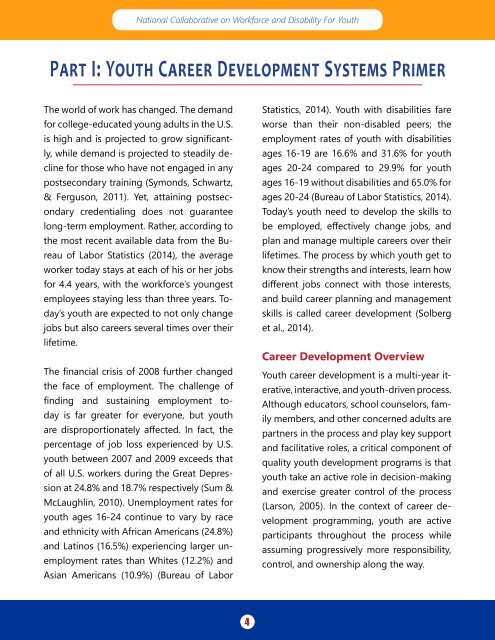Designing Statewide Strategies & Programs
DesigningStatewideCareerDevelopmentStrategiesProgramsPub_0
DesigningStatewideCareerDevelopmentStrategiesProgramsPub_0
Create successful ePaper yourself
Turn your PDF publications into a flip-book with our unique Google optimized e-Paper software.
National Collaborative on Workforce and Disability For Youth<br />
Part I: Youth Career Development Systems Primer<br />
The world of work has changed. The demand<br />
for college-educated young adults in the U.S.<br />
is high and is projected to grow significantly,<br />
while demand is projected to steadily decline<br />
for those who have not engaged in any<br />
postsecondary training (Symonds, Schwartz,<br />
& Ferguson, 2011). Yet, attaining postsecondary<br />
credentialing does not guarantee<br />
long-term employment. Rather, according to<br />
the most recent available data from the Bureau<br />
of Labor Statistics (2014), the average<br />
worker today stays at each of his or her jobs<br />
for 4.4 years, with the workforce’s youngest<br />
employees staying less than three years. Today’s<br />
youth are expected to not only change<br />
jobs but also careers several times over their<br />
lifetime.<br />
The financial crisis of 2008 further changed<br />
the face of employment. The challenge of<br />
finding and sustaining employment today<br />
is far greater for everyone, but youth<br />
are disproportionately affected. In fact, the<br />
percentage of job loss experienced by U.S.<br />
youth between 2007 and 2009 exceeds that<br />
of all U.S. workers during the Great Depression<br />
at 24.8% and 18.7% respectively (Sum &<br />
McLaughlin, 2010). Unemployment rates for<br />
youth ages 16-24 continue to vary by race<br />
and ethnicity with African Americans (24.8%)<br />
and Latinos (16.5%) experiencing larger unemployment<br />
rates than Whites (12.2%) and<br />
Asian Americans (10.9%) (Bureau of Labor<br />
Statistics, 2014). Youth with disabilities fare<br />
worse than their non-disabled peers; the<br />
employment rates of youth with disabilities<br />
ages 16-19 are 16.6% and 31.6% for youth<br />
ages 20-24 compared to 29.9% for youth<br />
ages 16-19 without disabilities and 65.0% for<br />
ages 20-24 (Bureau of Labor Statistics, 2014).<br />
Today’s youth need to develop the skills to<br />
be employed, effectively change jobs, and<br />
plan and manage multiple careers over their<br />
lifetimes. The process by which youth get to<br />
know their strengths and interests, learn how<br />
different jobs connect with those interests,<br />
and build career planning and management<br />
skills is called career development (Solberg<br />
et al., 2014).<br />
Career Development Overview<br />
Youth career development is a multi-year iterative,<br />
interactive, and youth-driven process.<br />
Although educators, school counselors, family<br />
members, and other concerned adults are<br />
partners in the process and play key support<br />
and facilitative roles, a critical component of<br />
quality youth development programs is that<br />
youth take an active role in decision-making<br />
and exercise greater control of the process<br />
(Larson, 2005). In the context of career development<br />
programming, youth are active<br />
participants throughout the process while<br />
assuming progressively more responsibility,<br />
control, and ownership along the way.<br />
4


